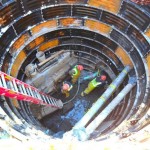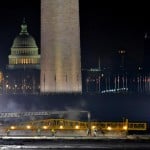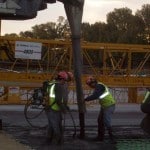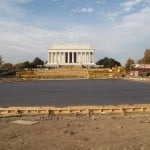Since its founding, Corman Construction has specialized in large, civic overhaul projects that require significant engineering and labor. But when the fourth generation-owned company, whose projects had mainly consisted of bridge and highway construction, signed on to rebuild the cracked and sinking Lincoln Memorial Reflecting Pool, it faced completely new challenges. The revitalized pool needed a water-treatment plant built along with it, it had to adhere to the original monument’s historic appearance, and the project also called for a new, more secure plaza in front of the Lincoln Memorial. Over the course of two years, Corman meticulously worked through the project’s various steps, and the company opened a fully rehabbed reflecting pool and neighboring plaza to the public in September 2012. Project manager Rick Richardson and senior project engineer Tom Mulcahy walked American Builders Quarterly through the painstaking process.
1. Demolish the existing pool
First, the concrete base of the pool had to be removed, and the real challenge of this opening step was what lay underneath the concrete. “It was hazardous waste removal,” Mulcahy says. “There was a layer of asbestos under the concrete, so the entire pool was considered hazardous waste.” Corman subcontracted Celtic Demolition, Inc. to break up the concrete and load it into a dumpster, and Celtic hired an outside consultant, Progressive Environmental Services, Inc., to set up exclusion zones and guide the waste material to the right disposal grounds. All the waste had to be carefully recorded and tracked, and site workers were required to wear protective clothing.
“There was a layer of asbestos under the concrete, so the entire pool was considered hazardous waste.”
Tom Mulcahy
Sr. Project Engineer
2. Stabilize the fresh ground
The ground that was left exposed after demolition was soft and very wet. To stabilize the new pool bottom that would be poured in, Corman had to install timber piles, each about 50 feet long. The pool is about 2,000 feet long and 160 feet wide, so the company had to bring in close to 5,000 timber piles from Atlantic Wood Industries to cover the entire area. Piles were driven down about 50 feet to bedrock, where they could support the fresh concrete.
3. Pour the concrete
Before pouring the new layer of concrete, Corman had to pour small-grade beams into the space. “They’re like caps over the piles, on top of which we pour a new slab,” Mulcahy says. It took Corman about four months to pour 15,000 yards of eight-inch-deep concrete in 160-by-60-foot patches. “It was done mostly in the winter time,” Richardson says, “so it was about just getting through a long process.” The concrete also had to be a custom dark-gray color, meaning every pour had to be properly colored and cured to be uniform. “So you don’t have a checkerboard effect,” Richardson explains.
4. Restore the pool’s border
The granite stones that border the reflecting pool presented a unique challenge in that each one had to be individually restored to maintain the pool’s historic aesthetic. The slabs were the same ones that had been installed in 1920, and while granite is resilient, the stones were starting to show their wear. Corman subcontracted Lorton Stone, LLC to do the restoration work on the border slabs, and Lorton also did the granite work on the Lincoln Memorial Plaza. “They did the majority of all our final cosmetic stonework,” Mulcahy says.
5. Install new piping
As work on the pool progressed, Corman had to tackle the enormous tasks of installing new piping and building a water-treatment building about 200 yards away from the pool. The firm installed 8,000 linear feet of HDPE piping, which is a specially fused pipe made out of plastic-like material, to pump water to and from the new pool. “The biggest challenge with that was the measurements,” Mulcahy says. “The way you install the pipes is really critical because each one has to come up a certain length and fit into a puzzle. … A lot of planning went into that ahead of time, as far as laying the pipes out and knowing where everything needed to be.”
6. Pave the walkways
Before the project began, pedestrians had worn a dirt path into the grass surrounding the reflecting pool. As part of the rehab, the National Park Service wanted to build a new walkway around the pool for pedestrians. Corman installed a 15-foot-wide walkway on either side of the pool with an exposed aggregate concrete finish, which involves pouring concrete retarder on top of the concrete and washing it away to leave the mixture’s stones exposed. This technique, undertaken by subcontractor Metro Paving Corporation, was tricky, Richardson says, because, again, every pour had to look the same.
7. Secure the site
The final leg of the project was the rebuilding of the north and south plazas in front of the Lincoln Memorial. This step included new concrete security walls, so Corman installed 15-foot-thick barriers layered with granite slabs that aesthetically blend with the rest of the memorial while still serving a protective role. In addition to stationary bollards, Corman installed retractable ones, which can be lowered into the ground whenever it’s necessary to bring vehicles past the barrier. The firm also put in new lighting next to the freshly paved walkways under the memorial’s famous elm trees, turning the monument into even more of an evening spectacle than before.













